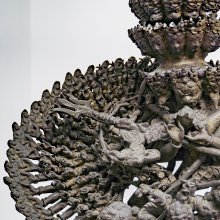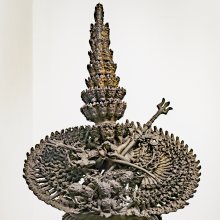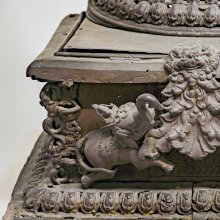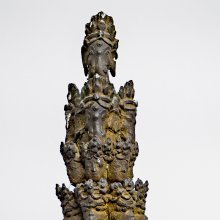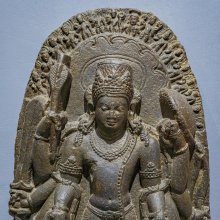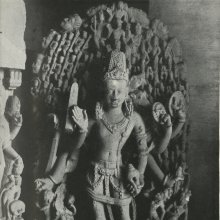Vishvarupa, Vishva-rupa, Viśvarūpā, Visvarupa, Viśvarūpa: 26 definitions
Introduction:
Vishvarupa means something in Buddhism, Pali, Hinduism, Sanskrit, Jainism, Prakrit, Marathi. If you want to know the exact meaning, history, etymology or English translation of this term then check out the descriptions on this page. Add your comment or reference to a book if you want to contribute to this summary article.
The Sanskrit terms Viśvarūpā and Viśvarūpa can be transliterated into English as Visvarupa or Vishvarupa, using the IAST transliteration scheme (?).
Images (photo gallery)
(+10 more images available)
In Hinduism
Shaivism (Shaiva philosophy)
Source: Manblunder: Sri Rudram 4.1-6Viśvarūpa means omnipresent, manifold nature of Brahman. The Brahman has different forms and shapes as the Brahman exists in every living and non-living being in this universe. In the case of non-living beings, they do not have souls and hence no action takes place on their own. There is no place in the universe, where the Brahman does not exist. The creation takes place first in the form of total darkness. From this darkness intellect arises. From intellect the ego and this ego gives rise to the modifications of the five elements which ultimately creates lives in this universe.
Source: SOAS University of London: Protective Rites in the Netra Tantra1) Viśvarūpa (विश्वरूप) refers to the “manifold [oṃ]”, according to the Netratantra of Kṣemarāja: a Śaiva text from the 9th century in which Śiva (Bhairava) teaches Pārvatī topics such as metaphysics, cosmology, and soteriology.—Accordingly, [verse 2.20-22ab]—“[The Mantrin] should worship the mother of Mantras with the highest bhakti, by spreading flowers and perfume, O Devī. He should extract the deity invoked by the Mantra [with the mantra]. Beginning with the all-pervading and ending with manifold [oṃ] (viśvarūpa—viśvarūpāntaṃ), [he should] always [worship with] the nectar of the white flower. The bright sound is highest Śakti, [who] resembles one-in-the-same Śiva. By this [worship] the pearls [of the mantra] are all bound in a cord”.
2) Viśvarūpa (विश्वरूप) refers to “having many forms” and is used to describe Viṣṇu.—Accordingly, [verse 13.1-9, while describing the appearance and worship of Viṣṇu]—“Or, [the Mantrin] worships a very handsome, eight-armed, yellow Deva. [...] He remembers [Viṣṇu’s] many forms (viśvarūpa). Thus, he thinks [of him] with a collection of many faces, many weapons and [many] arms [i.e., the cosmic Viṣṇu], reclining, taking a wife, joined with Lakṣmī, alone, [as] Narasiṃha, Varāha, or Vāmana, Kapila, or an honorable man, unadorned, or even without parts. [...]”.

Shaiva (शैव, śaiva) or Shaivism (śaivism) represents a tradition of Hinduism worshiping Shiva as the supreme being. Closely related to Shaktism, Shaiva literature includes a range of scriptures, including Tantras, while the root of this tradition may be traced back to the ancient Vedas.
Purana and Itihasa (epic history)
Source: archive.org: Puranic Encyclopedia1) Viśvarūpa (विश्वरूप).—A Rākṣasa (giant). Mention is made in Mahābhārata, Sabhā Parva, Chapter 9, Stanza 14, that this giant sits in the palace of Varuṇa glorifying him.
2) Viśvarūpa (विश्वरूप).—The son of Tvaṣṭā, the son of Viśvakarmā. This Viśvarūpa is also known as Triśiras. (For further details see under Indra, Para 7).
3) Viśvarūpā (विश्वरूपा).—The wife of Sage Dharma. It is stated in Vāyu Purāṇa that from sage Dharma, a daughter named Dharmavratā was born to Viśvarūpā.
Source: archive.org: Shiva Purana - English TranslationViśvarūpa (विश्वरूप) refers to “multi-formed” or “one of cosmic form” and is used to describe Śiva, according to the Śivapurāṇa 2.2.42.—Accordingly, as Dakṣa bowed and eulogised Śiva:—“I bow to the great lord, the supreme being, the bestower of boons, the store of knowledge, the eternal. I bow to Śiva, the lord of the chief of Gods, always conferring happiness and the sole kinsman of the universe. I bow to the lord of the universe, of cosmic form (i.e., Viśvarūpa), the primordial Being and the form of Brahman itself. I bow to Śiva, the conceiver of world’s happiness and the greater than the greatest. [...]”.
Source: Cologne Digital Sanskrit Dictionaries: The Purana Index1a) Viśvarūpa (विश्वरूप).—A son of Tvaṣṭri and Rocanā (Yaśodharā, Brahmāṇḍa-purāṇa) adopted by Suragaṇas when their guru Angiras left them. At first he did not agree as Paurodhasa was not a coveted profession. Finally he accepted and initiated Indra into a mantra known as varma nārāyaṇātmaka; with this Indra enjoyed once more the Trailokyalakṣmī: Father of Pañcajanī.1 Viśvarūpa had three heads Somapīṭḥa, Surāpīṭḥa, and Annāda. Finding the ācārya giving a part of his sacrificial offerings to Asuras, Indra cut off his heads which became Kapiñjala, Kalavinka and Tittiri birds. His vadha,2 in the sabhā of Hiraṇyakaśipu.3
- 1) Bhāgavata-purāṇa VI. 6. 44-5; ch. 7-8 (whole); V. 7. 1; Brahmāṇḍa-purāṇa III. 1. 86.
- 2) Bhāgavata-purāṇa VI. 9. 1-5; 13. 5.
- 3) Matsya-purāṇa 161. 80.
1b) A Śukradeva (ajita).*
- * Brahmāṇḍa-purāṇa II. 13. 94; Vāyu-purāṇa 31. 7.
1c) A son of Rūpavatī, and devoted to Nārāyaṇa: elected Purohita in the absence of Bṛhaspati who went to the earth due to a curse by sages: Indra quarrelled with him, and the latter repaired to spend his life in penance. Sages cursed Indra for this.*
- * Brahmāṇḍa-purāṇa IV. 9. 4-8.
1d) A name of Triśiras, a son of Tvaṣṭa.*
- * Vāyu-purāṇa 65. 85.
2a) Viśvarūpā (विश्वरूपा).—In the 33rd Kalpa Sarasvatī became Viśvarūpā with four hands, four feet, four teeth, four eyes, etc. Brahmā prayed to Viśveśa who explained the nature of Sarasvatī as Prakṛti and made aṭṭahāsa when Jati, Muṇḍi and other sons came; after performing austerities for 1000 years they attained Rudrahood.*
- * Vāyu-purāṇa 23. 36-61.
2b) Wife of Dharma and mother of Dharmavratā.*
- * Vāyu-purāṇa 107. 2.
Viśvarūpa (विश्वरूप) is a name mentioned in the Mahābhārata (cf. XIV.8) and represents one of the many proper names used for people and places. Note: The Mahābhārata (mentioning Viśvarūpa) is a Sanskrit epic poem consisting of 100,000 ślokas (metrical verses) and is over 2000 years old.
Viśvarūpa is also mentioned in the Mahābhārata (cf. II.9.14) and represents one of the many proper names used for people and places.

The Purana (पुराण, purāṇas) refers to Sanskrit literature preserving ancient India’s vast cultural history, including historical legends, religious ceremonies, various arts and sciences. The eighteen mahapuranas total over 400,000 shlokas (metrical couplets) and date to at least several centuries BCE.
Shilpashastra (iconography)
Source: Wisdom Library: Śilpa-śāstraViśvarūpa (विश्वरूप) is a Sanskrit name referring to one of the eight manifestations of Ruru, who is a form of Bhairava. According to the Rudrayāmala, there are eight main forms of Bhairava who control the eight directions of this universe. Each form (e.g., Ruru) has a further eight sub-manifestations (e.g., Viśvarūpa), thus resulting in a total of 64 Bhairavas.
When depicting Viśvarūpa according to traditional iconographic rules (śilpaśāstra), one should depcit him (and other forms of Ruru) having a pure white color, adorned with ornaments set with rubies; he should carry an akṣamālā, the aṅkuśa, a pustaka and a vīṇā. The word Śilpaśāstra refers to an ancient Hindu science of arts and crafts, dealing with subjects such as painting, sculpture and iconography.

Shilpashastra (शिल्पशास्त्र, śilpaśāstra) represents the ancient Indian science (shastra) of creative arts (shilpa) such as sculpture, iconography and painting. Closely related to Vastushastra (architecture), they often share the same literature.
Pancaratra (worship of Nārāyaṇa)
Source: Wisdom Library: PāñcarātraViśvarūpa (विश्वरूप) refers to an aspect of nṛsiṃha (‘man-lion’), according to the Vihagendra-saṃhitā 4.17, which mentions seventy-four forms (inlcuding twenty forms of vyūha). He is also known as Viśvarūpanṛsiṃha or Viśvarūpanarasiṃha. Nṛsiṃha is a Tantric deity and refers to the furious (ugra) incarnation of Viṣṇu.
The 15th-century Vihagendra-saṃhīta is a canonical text of the Pāñcarātra corpus and, in twenty-four chapters, deals primarely with meditation on mantras and sacrificial oblations.
Source: archive.org: Isvara Samhita Vol 1Viśvarūpa (विश्वरूप) refers to one of the various Vibhava manifestations according to the Īśvarasaṃhitā 24.217-231.—Accordingly, “that God, Lord of all, who stays within as a witness (of all deeds of the person within whom He stays) bears all the things as a crystal bears the existent things by His power in order that (His) devotees who are exposed to nescience, could get a good status. Of him (Viśvarūpa), one shall think as having no beginning, who is the lord of the worlds and who is staying between the sky and earth, externally in a gross form. He has many faces, feet and eyes marked by many (emblems) fish. Though He has many faces and bedecked with many hands, He is (admitted to) having various faces thirty-three in number, has huge divine hands forty-four in number. Brahmā, Rudra, Indra, Dakṣa, sun, moon, siddhas and Vedas are in His face above the mouth of man”.
These Vibhavas (e.g., Viśvarūpa) represent the third of the five-fold manifestation of the Supreme Consciousness the Pāñcarātrins believe in. Note: the name Viśvarūpa for this prādurbhāva (appearance) is significat in that the description of the form given here is highly suggestive of the form of god contained in the 11th chapter of the Bhagavadgītā which is well-known as Viśvarūpādhyāya (vide Tātparyacandrikā of Vedāntadeśika on Ramanuja’s Bhagavadgītābhāṣya. Introduction, Chapter XI)

Pancaratra (पाञ्चरात्र, pāñcarātra) represents a tradition of Hinduism where Narayana is revered and worshipped. Closeley related to Vaishnavism, the Pancaratra literature includes various Agamas and tantras incorporating many Vaishnava philosophies.
Vyakarana (Sanskrit grammar)
Source: Wikisource: A dictionary of Sanskrit grammarViśvarūpa (विश्वरूप).—A grammarian of the sixteenth century who has written a small grammar treatise called विश्वरूप-निबन्ध (viśvarūpa-nibandha).

Vyakarana (व्याकरण, vyākaraṇa) refers to Sanskrit grammar and represents one of the six additional sciences (vedanga) to be studied along with the Vedas. Vyakarana concerns itself with the rules of Sanskrit grammar and linguistic analysis in order to establish the correct context of words and sentences.
Vaishnavism (Vaishava dharma)
Source: Pure Bhakti: Bhagavad-gita (4th edition)Viśvarūpa (विश्वरूप) refers to “universal form”. (cf. Glossary page from Śrīmad-Bhagavad-Gītā).

Vaishnava (वैष्णव, vaiṣṇava) or vaishnavism (vaiṣṇavism) represents a tradition of Hinduism worshipping Vishnu as the supreme Lord. Similar to the Shaktism and Shaivism traditions, Vaishnavism also developed as an individual movement, famous for its exposition of the dashavatara (‘ten avatars of Vishnu’).
Shaktism (Shakta philosophy)
Source: Google Books: ManthanabhairavatantramViśvarūpa (विश्वरूप) and Viśvarūpiṇī refers to the pair of God and Goddess appearing in the fourth Kalpa (aeon), according to the Kularatnoddyota.—Chapter nine of the Kularatnoddyota opens with the goddess asking how the Kula tradition (kulāmnāya) will be worshipped along with its mantras and Vidyās and who will bring it down (avatāraka) into the world in the various cosmic aeons (kalpa). After explaining that it is brought down into the world by incarnations or aspects of both the god and the goddess (aṃśamātra), the god goes on to list the names of these aspects—a goddess and her consort [i.e., Viśvarūpiṇī—Viśvarūpa]—in nineteen aeons (kalpa), many of which we recognize from the earlier version in the Tantrasadbhāva.—(cf. Jayadrathayāmala-tantra of the Kāpālikas).

Shakta (शाक्त, śākta) or Shaktism (śāktism) represents a tradition of Hinduism where the Goddess (Devi) is revered and worshipped. Shakta literature includes a range of scriptures, including various Agamas and Tantras, although its roots may be traced back to the Vedas.
Jyotisha (astronomy and astrology)
Source: Wisdom Library: Brihat Samhita by VarahamihiraViśvarūpa (विश्वरूप) or Viśvarūpaketu refers to certain types of Ketus (i.e., luminous bodies such as comets and meteors), according to the Bṛhatsaṃhitā (chapter 11), an encyclopedic Sanskrit work written by Varāhamihira mainly focusing on the science of ancient Indian astronomy astronomy (Jyotiṣa).—Accordingly, “The comets that resemble the flaming fire or a garland are 120 in number. They are the sons of Agni and are named Viśvarūpa Ketus. When they appear there will be fear from fire. The comets that are dark-red in colour, without disc, presenting the appearance of Cāmara and with scattered rays are named Aruṇa Ketus. They are the sons of Vāyu (the wind) and are 77 in number; when they appear mankind will feel miserable”.

Jyotisha (ज्योतिष, jyotiṣa or jyotish) refers to ‘astronomy’ or “Vedic astrology” and represents the fifth of the six Vedangas (additional sciences to be studied along with the Vedas). Jyotisha concerns itself with the study and prediction of the movements of celestial bodies, in order to calculate the auspicious time for rituals and ceremonies.
General definition (in Hinduism)
Source: WikiPedia: HinduismVisvarupa (विस्वरुप): Name of Twashta's son who became the preceptor of the gods, Brihaspati having left when insulted by Indra.
In Buddhism
Tibetan Buddhism (Vajrayana or tantric Buddhism)
Source: WikiPedia: Tibetan BuddhismViśvarūpa (विश्वरूप) (in Tibetan: Natshog Zug(chän)) (1127–1227 CE) refers to the thirteenth of the twenty-five Kalki kings (of Shambhala) who represents the holders of the Kalachakra (“wheel of time”) teachings of Buddha Shakyamuni.—The king Viśvarūpa is described as “holder of the vajra prod and noose”.

Tibetan Buddhism includes schools such as Nyingma, Kadampa, Kagyu and Gelug. Their primary canon of literature is divided in two broad categories: The Kangyur, which consists of Buddha’s words, and the Tengyur, which includes commentaries from various sources. Esotericism and tantra techniques (vajrayāna) are collected indepently.
In Jainism
General definition (in Jainism)
Source: The University of Sydney: A study of the Twelve ReflectionsViśvarūpa (विश्वरूप) refers to “consisting of the intellectual faculty”, according to the 11th century Jñānārṇava, a treatise on Jain Yoga in roughly 2200 Sanskrit verses composed by Śubhacandra.—Accordingly, “This self is, by nature, different from the body, etc., consisting of consciousness and bliss [com.—viśvarūpa—‘consisting of the intellectual faculty’] , pure and united with mundane bondage. In reality, there is no unity of the forms of matter and consciousness with regard to mundane bondage and the connection of these two is without a beginning like gold and a flaw in gold”.

Jainism is an Indian religion of Dharma whose doctrine revolves around harmlessness (ahimsa) towards every living being. The two major branches (Digambara and Svetambara) of Jainism stimulate self-control (or, shramana, ‘self-reliance’) and spiritual development through a path of peace for the soul to progess to the ultimate goal.
Languages of India and abroad
Marathi-English dictionary
Source: DDSA: The Molesworth Marathi and English Dictionaryviśvarūpa (विश्वरूप).—a S That takes or exists in all forms; that is in every substance in the universe. A title of brahma q. v.
Marathi is an Indo-European language having over 70 million native speakers people in (predominantly) Maharashtra India. Marathi, like many other Indo-Aryan languages, evolved from early forms of Prakrit, which itself is a subset of Sanskrit, one of the most ancient languages of the world.
Sanskrit dictionary
Source: DDSA: The practical Sanskrit-English dictionaryViśvarūpa (विश्वरूप).—a. omnipresent, existing everywhere; तस्मिन् यशो निहितं विश्वरूपम् (tasmin yaśo nihitaṃ viśvarūpam) Bṛ. Up.2.2.2.
-paḥ an epithet of Viṣṇu.
-pam agallochum.
Viśvarūpa is a Sanskrit compound consisting of the terms viśva and rūpa (रूप).
Source: Cologne Digital Sanskrit Dictionaries: Shabda-Sagara Sanskrit-English DictionaryViśvarūpa (विश्वरूप).—mfn.
(-paḥ-pī-paṃ) Taking all forms, existing in all forms, universal, omnipresent. m.
(-paḥ) Vishnu. n.
(-paṃ) Agallochum. E. viśva all, rūpa form.
Source: Cologne Digital Sanskrit Dictionaries: Benfey Sanskrit-English DictionaryViśvarūpa (विश्वरूप).—I. adj. taking all forms, omnipresent. Ii. m. Viṣṇu.
Viśvarūpa is a Sanskrit compound consisting of the terms viśva and rūpa (रूप).
Source: Cologne Digital Sanskrit Dictionaries: Cappeller Sanskrit-English DictionaryViśvarūpa (विश्वरूप).—([feminine] ā & viśvarūpī) [adjective] many-coloured, multiform, manifold, various. [masculine] [Epithet] of Viṣṇu, [Name] of a son of Tvaṣṭṛ, of an Asura, & of [several] men.
Source: Cologne Digital Sanskrit Dictionaries: Aufrecht Catalogus Catalogorum1) Viśvarūpa (विश्वरूप) as mentioned in Aufrecht’s Catalogus Catalogorum:—[dharma] Oppert. 3010. 6209 ([anonymous]).
2) Viśvarūpa (विश्वरूप):—lexicographer. Quoted by Maheśvara Oxf. 188^a, by Medinīkara, by Bhaṭṭoji Oxf. 162^b.
3) Viśvarūpa (विश्वरूप):—lawyer. Quoted by Hemādri in Pariśeṣakhaṇḍa 1, 159, by Śūlapāṇi Oxf. 283^a, in Madanapārijāta, by Vācaspatimiśra Oxf. 273^b, by Allāḍanātha W. p. 332, by Raghunandana in Dāyabhāgatattva, by Kamalākara in Nirṇayasindhu, and others. See Viśvarūpanibandha and Viśvarūpasamuccaya. Perhaps it is the same author who wrote a
—[commentary] to the Yājñavalkyasmṛti, and is quoted by Vijñāneśvara Oxf. 356^a.
4) Viśvarūpa (विश्वरूप):—civilly called Maṇḍanamiśra, a disciple of Śaṅkarācārya: Kāśīmokṣanirṇaya. Taittirīyaśrutivārttika. Naiṣkarmyasiddhi. Pañcīkaraṇavārttika. Bṛhadāraṇyakopaniṣadvārttika. Brahmasiddhi. Brahmasūtrabhāṣyavārttika. Compare Vivaraṇatattvadīpana. Bhāvanāviveka. Mānasollāsa or Dakṣiṇāmūrtistotravārttika. Laghuvārttika. Vārttika (which?). Np. Viii, 38. Oppert. 1646. Ii, 5070. Vārttikasāra. Vārttikasārasaṃgraha.
Viśvarūpa has the following synonyms: Sureśvara ācārya.
5) Viśvarūpa (विश्वरूप):—lawyer. Quoted by Devaṇṇa in Vyavahārakāṇḍa, and said to be later than Dhāreśvara.
6) Viśvarūpa (विश्वरूप):—Siddhāntadīpikā [nyāya]
Source: Cologne Digital Sanskrit Dictionaries: Monier-Williams Sanskrit-English Dictionary1) Viśvarūpa (विश्वरूप):—[=viśva-rūpa] [from viśva] n. sg. various forms, [Manu-smṛti; Pañcarātra; Rāmatāpanīya-upaniṣad]
2) [v.s. ...] mf(ā or ī)n. many-coloured, variegated, [Ṛg-veda; Atharva-veda] etc.
3) [v.s. ...] wearing all forms, manifold, various, [Ṛg-veda; Atharva-veda; Taittirīya-saṃhitā] etc.
4) [v.s. ...] m. Name of [particular] comets, [Varāha-mihira’s Bṛhat-saṃhitā]
5) [v.s. ...] of Śiva, [Mahābhārata]
6) [v.s. ...] of Viṣṇu-Kṛṣṇa, [Catalogue(s)]
7) [v.s. ...] of a son of Tvaṣṭṛ (whose three heads were struck off by Indra), [Ṛg-veda; Taittirīya-saṃhitā; Brāhmaṇa] etc.
8) [v.s. ...] of an Asura, [Mahābhārata; Harivaṃśa]
9) [v.s. ...] of various scholars etc. ([especially] of a [Scholiast or Commentator] on [Yājñavalkya]), [Manvarthamuktāvalī, kullūka bhaṭṭa’s Commentary on manu-smṛti; Catalogue(s)] etc.
10) Viśvarūpā (विश्वरूपा):—[=viśva-rūpā] [from viśva-rūpa > viśva] f. a dappled cow, [Ṛg-veda; Vājasaneyi-saṃhitā; Taittirīya-brāhmaṇa]
11) [v.s. ...] Name of [particular] verses (e.g. [Ṛg-veda v, 81, 2]), [Brāhmaṇa; Lāṭyāyana]
12) [v.s. ...] [plural] the yoked horses of Bṛhas-pati, [Naighaṇṭuka, commented on by Yāska]
13) Viśvarūpa (विश्वरूप):—[=viśva-rūpa] [from viśva] n. Agallochum, [Horace H. Wilson]
14) [v.s. ...] ([probably]) n. Name of [work]
Source: Cologne Digital Sanskrit Dictionaries: Yates Sanskrit-English DictionaryViśvarūpa (विश्वरूप):—[viśva-rūpa] (paḥ-pī-paṃ) a. Taking all forms, omnipresent. m. Vishnu. n. Agallochum.
[Sanskrit to German]
Sanskrit, also spelled संस्कृतम् (saṃskṛtam), is an ancient language of India commonly seen as the grandmother of the Indo-European language family (even English!). Closely allied with Prakrit and Pali, Sanskrit is more exhaustive in both grammar and terms and has the most extensive collection of literature in the world, greatly surpassing its sister-languages Greek and Latin.
Kannada-English dictionary
Source: Alar: Kannada-English corpusViśvarūpa (ವಿಶ್ವರೂಪ):—
1) [noun] Viṣṇu.
2) [noun] the form of Viṣṇu which is manifested in every object of the universe.
3) [noun] Śiva.
4) [noun] a kind of black-magic.
5) [noun] the tendency to change one’s forms, outlook, attitude, preference, etc. to take full advantage of different circumstances.
Kannada is a Dravidian language (as opposed to the Indo-European language family) mainly spoken in the southwestern region of India.
See also (Relevant definitions)
Partial matches: Vishva, Rupa.
Starts with (+10): Vishvarupa acarya, Vishvarupa bharati, Vishvarupa ganaka, Vishvarupa keshava, Vishvarupacarya, Vishvarupadarshana, Vishvarupadeva, Vishvarupadhara, Vishvarupagana, Vishvarupaganakamunishvara, Vishvarupaka, Vishvarupakeshava, Vishvarupaketu, Vishvarupakrishna, Vishvarupam, Vishvarupamaya, Vishvarupanarasimha, Vishvarupanibandha, Vishvarupanivandha, Vishvarupanrisimha.
Ends with: Bharativishvarupa, Keshava vishvarupa.
Full-text (+104): Traishirsha, Vishvarupam, Vishvarupataricanam, Vaishvarupa, Pancajani, Vishvarupi, Munishvara, Vishvarupamaya, Vishvarupasamuccaya, Vishvarupavat, Vishvarupakeshava, Vishvarupadhara, Vishvarupadeva, Vishvarupaganakamunishvara, Vicuvarupai, Vishvarupadarshana, Vishvarupatama, Vishvarupatirtha, Vishvarupanibandha, Ramavishvarupastotra.
Relevant text
Search found 76 books and stories containing Vishvarupa, Vishva-rupa, Viśva-rūpa, Visva-rupa, Viśva-rūpā, Viśvarūpā, Visvarupa, Viśvarūpa; (plurals include: Vishvarupas, rupas, rūpas, rūpās, Viśvarūpās, Visvarupas, Viśvarūpas). You can also click to the full overview containing English textual excerpts. Below are direct links for the most relevant articles:
Rig Veda (translation and commentary) (by H. H. Wilson)
Shrimad Bhagavad-gita (by Narayana Gosvami)
Verse 11.16 < [Chapter 11 - Viśvarūpa-darśana-yoga (beholding the Lord’s Universal Form)]
Chapter 11 - Viśvarūpa-darśana-yoga (beholding the Lord’s Universal Form)
Verse 9.15 < [Chapter 9 - Rāja-guhya-yoga (Yoga through the most Confidential Knowledge)]
Chaitanya Bhagavata (by Bhumipati Dāsa)
Verse 2.19.106 < [Chapter 19 - The Lord’s Pastimes in Advaita’s House]
Verse 1.7.94 < [Chapter 7 - Śrī Viśvarūpa Takes Sannyāsa]
Verse 2.22.67 < [Chapter 22 - Delivering Śacīdevī from Offense and Descriptions of Nityānanda’s Qualities]
Song 12 < [Bālya-līlā (Ages 1-5—Pastimes)]
Song 13 < [Bālya-līlā (Ages 1-5—Pastimes)]
Song 4 < [Vandanā (offering obeisances)]
The Linga Purana (by J. L. Shastri)
Chapter 16 - Glory of Īśāna < [Section 1 - Uttarabhāga]
Chapter 51 - The Vidyā of Vajreśvarī < [Section 2 - Pūrvabhāga]
Chapter 23 - Various Kalpas < [Section 1 - Uttarabhāga]
Garga Samhita (English) (by Danavir Goswami)
Chapter 15 - Revelation of the Universal Form to Nanda’s Wife < [Canto 1 - Goloka-khaṇḍa]
Related products
